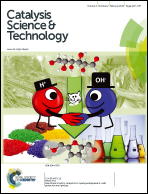Synthesis and characterization of chiral recyclable dimeric copper(ii)–salen complexes and their catalytic application in asymmetric nitroaldol (Henry) reaction†
Abstract
Six new chiral tridentate ditopic ligands with ONO donors possessing different linkers (either achiral or chiral) were synthesized. The characterization of these ligands was accomplished by IR, UV/Vis, NMR, mass spectrometry and optical rotation. These ligands have been treated with a series of metal ions viz., Cu(II), Cu(I), Co(III) and Zn(II), affording varieties of new chiral metal complexes, which have been characterized thoroughly using different analytical and spectroscopic methods. All the complexes were screened for catalytic asymmetric nitroaldol reaction using benzaldehyde as a model substrate. The reaction conditions were optimized and 79% yield with good enantioselectivity (88%) was achieved at RT with the in situ generated catalyst having a piperazine linker and (1R,2S)-2-amino-1,2-diphenylethanol collar in combination with cupric acetate as the metal source. By applying other aromatic and aliphatic aldehydes, similar yields of β-nitroalcohols with improved enantioselectivities (up to 93%) were achieved. The catalytic system worked very well for up to four cycles with retention of activity and enantioselectivity of β-nitroalcohols.


 Please wait while we load your content...
Please wait while we load your content...